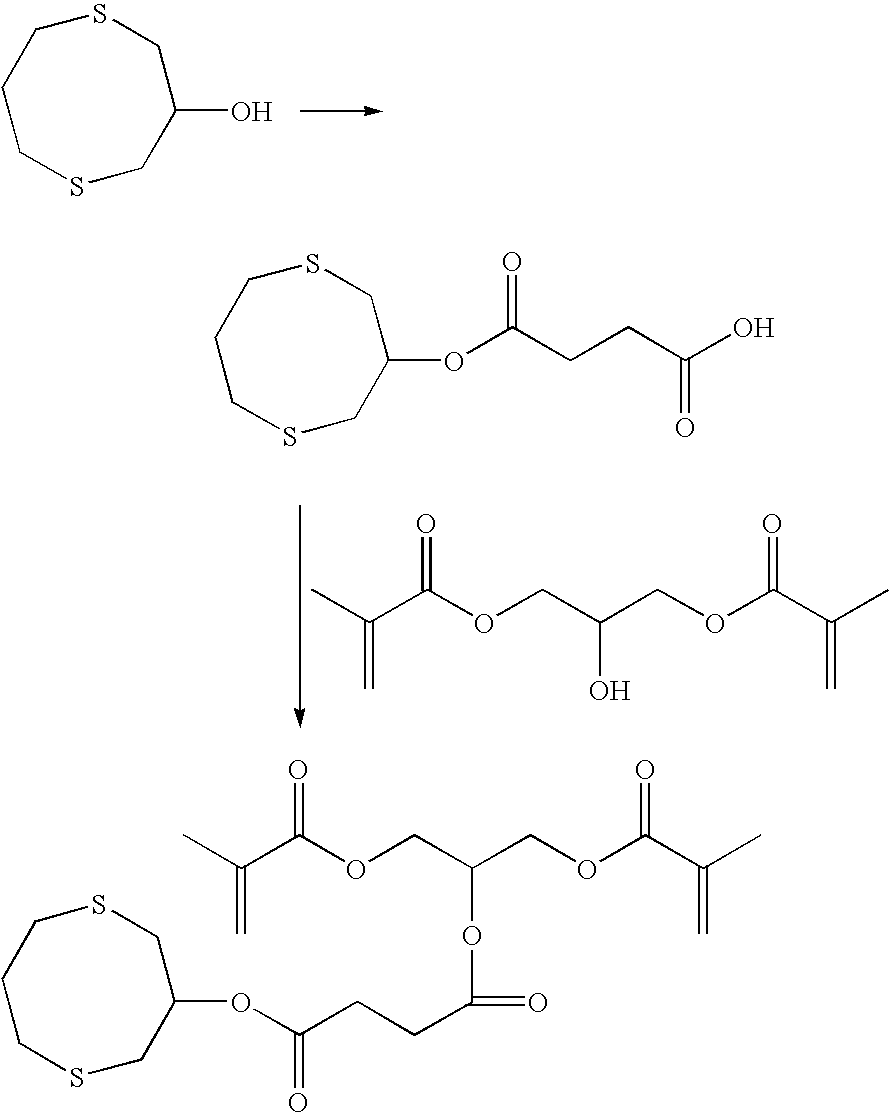Curable compositions containing dithiane monomers
a dithiane monomer and composition technology, applied in the field of curable compositions, can solve the problems of low mechanical properties, gap between the composite and the tooth structure, post-operative sensitivity, micro-leakage, etc., and achieve the effect of high mechanical properties and low shrinkag
- Summary
- Abstract
- Description
- Claims
- Application Information
AI Technical Summary
Benefits of technology
Problems solved by technology
Method used
Image
Examples
preparatory example 1
3-Hydroxy-1,5-dithiacyclooctane
[0092] A first solution of 1,3-propanedithiol (10.82 grams, 0.10 moles, commercially available from Alfa Aesar; Ward Hill, Mass.) and ethanol (45 milliliters) was placed in a 60-milliliter syringe. A second solution of epichlorohydrin (9.25 grams, 0.10 moles) and ethanol (45 milliliters) was placed in a second 60-milliliter syringe. Both solutions were slowly added dropwise to a mixture of sodium hydroxide (8.80 grams, 0.22 moles) and ethanol (250 milliliters) at room temperature over 10 hours. After stirring for an additional 8 hours, the reaction mixture was concentrated under vacuum, and then diluted with ethyl acetate (200 milliliters). The organic phase was washed with water (200 milliliters) and saturated sodium chloride in water (100 milliliters) and dried over magnesium sulfate. The solvent was removed under reduced pressure to give the crude product that was purified by column chromatography over silica gel using a mixture of ethyl acetate in...
example 1
1-(2-Methacryloyloxyethyl)-2-(1,5-dithiacyclooctan-3-yl) Succinate
[0093]
[0094] mono-2-Methacryloyloxyethyl succinate (4.20 grams, 18 millimoles) and 3-hydroxy-1,5-dithiacyclooctane (3.00 grams, 18 millimoles) were dissolved in methylene chloride (50 milliliters) in a 3-neck flask equipped with a magnetic stirring bar and nitrogen gas inlet. DMAP (0.22 grams, 2 millimoles) was added and the resulting mixture was cooled in an ice bath for 20 minutes. To the cooled solution was added DCC (4.14 grams, 20 millimoles). The resulting mixture was then stirred in the ice bath for 2 hours and room temperature for 16 hours. The resulting precipitate was removed by vacuum filtration. The filtrate was then washed once with saturated sodium bicarbonate (50 milliliters), and once with saturated sodium chloride in water (50 milliliters). After drying over magnesium sulfate, the solvent was removed under reduced pressure. The crude oil was purified by column chromatography over silica gel using a m...
example 2.1
(2-Methacryloyloxyethyl)-2-(1,5-dithiaoctan-3-yl) Phthalate
[0095]
[0096] Example 2 was prepared following the general procedure of esterification described for Example 1 using 3-hydroxy-1,5-dithiacyclooctane and mono-2-Methacryloyloxyethyl phthalate. Purity and structure verification of Example 2 were confirmed by 1H NMR.
PUM
| Property | Measurement | Unit |
|---|---|---|
| wt. % | aaaaa | aaaaa |
| wt. % | aaaaa | aaaaa |
| wt. % | aaaaa | aaaaa |
Abstract
Description
Claims
Application Information
 Login to View More
Login to View More - R&D
- Intellectual Property
- Life Sciences
- Materials
- Tech Scout
- Unparalleled Data Quality
- Higher Quality Content
- 60% Fewer Hallucinations
Browse by: Latest US Patents, China's latest patents, Technical Efficacy Thesaurus, Application Domain, Technology Topic, Popular Technical Reports.
© 2025 PatSnap. All rights reserved.Legal|Privacy policy|Modern Slavery Act Transparency Statement|Sitemap|About US| Contact US: help@patsnap.com



